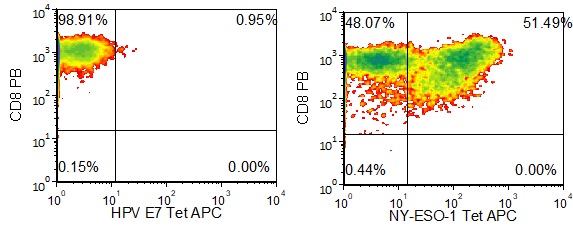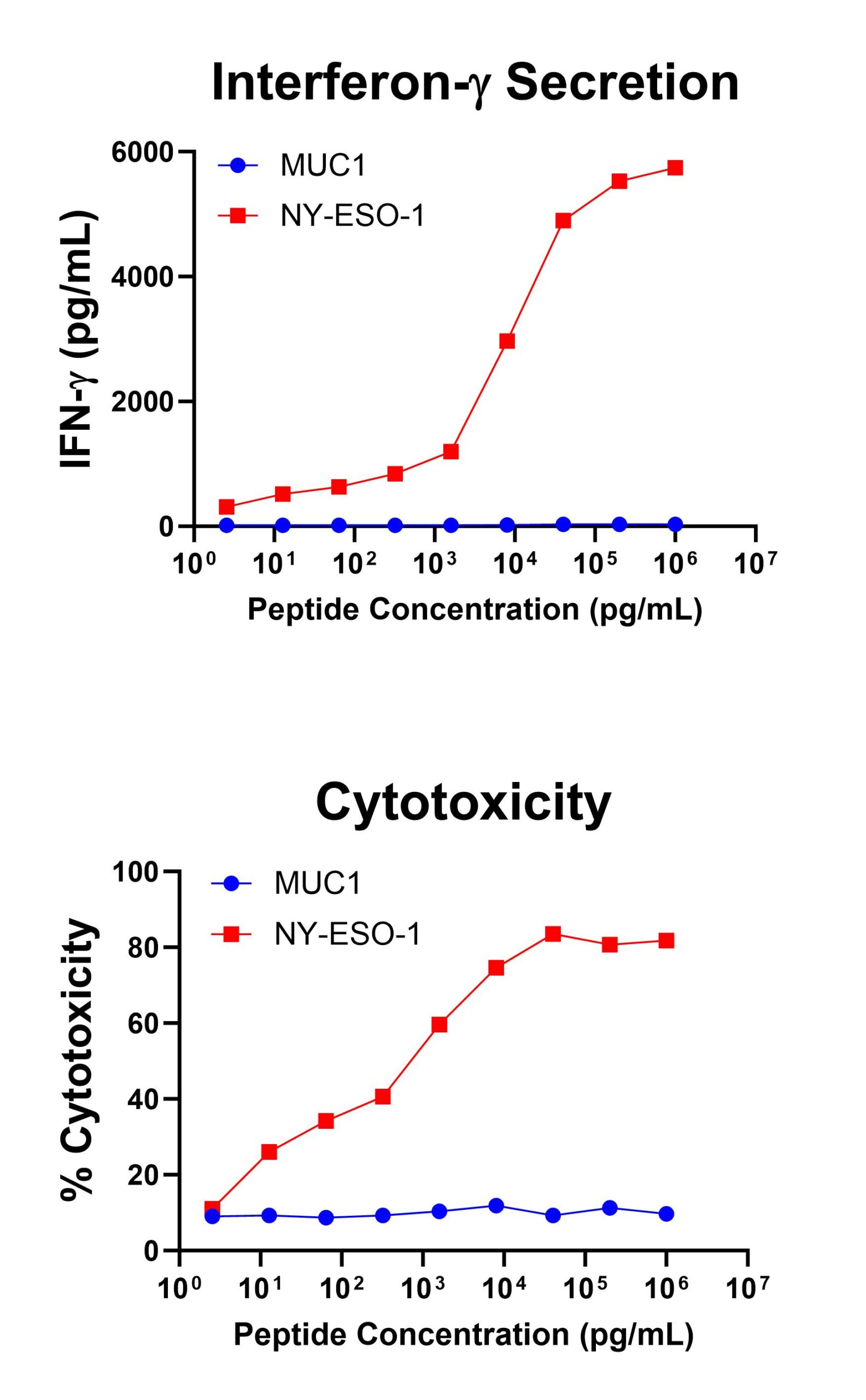Antigen-Specific T Cells Against NY-ESO-1 Antigen
Our scientists were among the first to develop custom antigen-specific T cells for research use and have created them against a diverse range of targets, including viral, tumor, and self-antigens.
We’re now developing the next generation of antigen-specific T cells to target some of today’s most prevalent and challenging diseases. More on that below. But first, a primer on antigen-specific T cells.
The Role of Antigen-Specific T Cells in Disease Research and Treatment
T cells are a major player in the immune response in various diseases, including cancer and pathogenic infections, and are mediators in inflammation and autoimmunity. A large body of research has been conducted over the past few decades to manipulate T cell responses, leading to many clinical strategies including cancer vaccines, T cell adoptive therapy, CAR-T therapy, immune-oncology, and the use of regulatory T cells for autoimmune diseases.
Antigen-specific T cells are an important tool in T cell biology research and potency assays. Investigators can isolate them directly from the disease site (e.g., tumor-infiltrating lymphocytes (TIL) or inflammatory lesion infiltrate populations), but these procedures often yield a limited number of cells due to low cell frequency and lack of robust isolation methods.
Alternatively, antigen-specific T cells can be generated in vitro using antigen-presenting cells pulsed with whole antigens or peptides. However, this process is often time-consuming with a low success rate.
About Ignyte Bio’s Antigen-Specific T Cells
Ignyte Bio offers antigen-specific T cells for research use you can rely on.
- Typically generated using multiple in vitro stimulations with peptide antigens
- Not immortalized or genetically modified, so they more closely mimic physiological T cells
- Specificity analyzed using the cognate peptide/MHC tetramer binding as well as interferon-gamma (IFN-γ) secretion assays.
Announcing Ignyte Bio’s Newest Antigen-Specific T Cell : anti-NY-ESO-1 CD8+ T Cells
NY-ESO-1 (New York esophageal squamous cell carcinoma 1), an 18 k-Da protein, is a well-known cancer testis antigen (CTAs). It is expressed in a wide range of tumor types, including neuroblastoma, myeloma, metastatic melanoma, synovial sarcoma, bladder cancer, esophageal cancer, hepatocellular cancer, head and neck cancer, non-small cell lung cancer, ovarian cancer, prostate cancer, and breast cancer. In contrast, its expression in normal tissues is limited to germ cells and placental cells (Thomas et. al., 2018).
The first report of T cell response against NY-ESO-1 was observed in a metastatic melanoma patient with a high-titer antibody response. Three HLA-A*0201 restricted epitopes in NY-ESO-1 were identified as the recognition sites for CD8+ cytotoxic T lymphocytes (Jager et. al., 1998).
One of the peptides, NY-ESO-1157-165 (SLLMWITQC), has been shown to be naturally processed in NY-ESO-1 expressing tumor cell lines. An analog with a valine for cysteine substitution in position 165: NY-ESO-1157-165, 165V (SLLMWITQV) is recognized 100 times more efficiently and is capable of stimulating the expansion of NY-ESO-1-specific CTL from peripheral blood of melanoma patients much more efficiently than wild-type peptide (Chen et. al., 2000) .
Ignyte Bio’s anti-NY-ESO-1-specific CD8+ T cells are generated against the analog peptide NY-ESO-1157-165, 165V, (SLLMWITQV).
Figure 1 shows specific recognition of the NY-ESO-1157-165, 165V in association with HLA-A-02:01 as shown by the tetramer binding study. Figure 2 shows specific IFN-γ secretion and specific lysis when HLA-A-02:01+ target cells were incubated with the NY-ESO-1157-165, 165V peptide but not the control HPV E711-20 peptide.

Figure 1. Recognition of Antigenic Peptide NY-ESO-1157-165, 165V) Demonstrated by Peptide/MHC Tetramer Binding Analysis. Cryopreserved T cells were thawed and stained with the tetramer HLA-A-02:01-NY-ESO-1157-165, 165V (SLLMWITQV, NY-ESO-1 Tetramer APC or the APC-labelled HLA-A-02:01-HPV E711-20 (YMLDLQPETT, HPV E7 control Tetramer. These cells were counterstained with anti-CD8 Pacific Blue reagent and analyzed by flow cytometry. Non-viable cells were excluded from the analysis using 7-AAD.

Figure 2. Antigen-Specific IFN-γ Secretion and Cytotoxicity Data. Freshly thawed anti-NY-ESO-1 CD8+ T cells were plated at 2 x 104 cells/well in the presence of 2 x 104 T2 cells, an HLA-A-02:01+ B-LCL (ATCC, Manassas, VA) and different concentrations of NY-ESO-1157-165, 165V (SLLMWITQV): NY-ESO-1 or MUC113-21 (LLLTVLTV): MUC1 control peptide in a 96-well round bottom plate. After 18-24 hours of incubation at 37oC, 5% CO2, culture supernatants were harvested and assayed for IFN-γ using the Lumit™ IFN-γ Immunoassay (Promega, Madison, WI). IFN-γ concentration is plotted against Tyrosinase and control peptide concentrations (upper graph). Remaining cells in each well were stained with the viability dye 7-AAD and analyzed using flow cytometry. % Cytotoxicity (= % 7-AAD+ target cells) is plotted against the respective peptide concentrations (lower graph).
